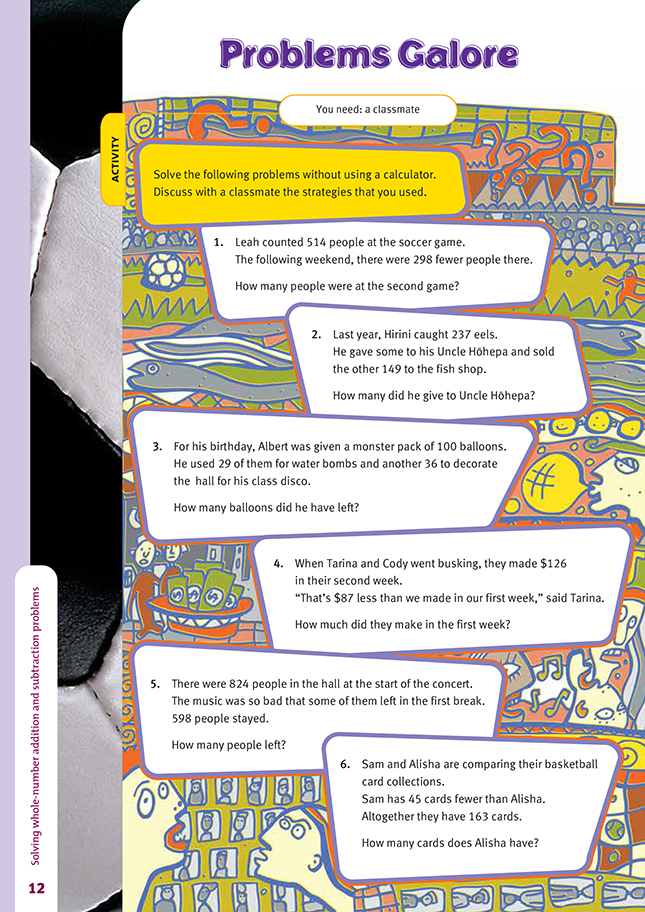This is a level 3 number link activity from the Figure It Out series. It relates to Stage 6 of the Number Framework.
A PDF of the student activity is included.
Click on the image to enlarge it. Click again to close. Download PDF (269 KB)
use mental strategies to solve addition and subtraction problems
FIO, Link, Number, Book Two, Problems Galore, page 12
A classmate
The students will need to read the problems in this activity carefully to correctly interpret the relationships between the given quantities. The ideas in the bulleted list below will help them to focus on finding these relationships before they think about doing a calculation. Give the students sufficient time to try things out and self-correct before telling them whether they are correct. Encourage them to follow these steps:
• Explore each problem by retelling it in their own words.
• Try to write an equation that shows the quantities in the correct relationship for the problem.
• Check the equation against the question to see if it matches the intention of the problem.
• Rearrange the correct equation in a way that makes it easy and efficient to get a result.
• Estimate before calculating exactly and then ask themselves “Is this a sensible answer?”
The students can then devise and share their own strategy for solving each equation. This is an ideal activity for them to work on in problem-solving groups. Four students per group is a good size.
Problem 1 is presented in a way that directly matches the traditional subtraction equation 514 – 298 = . The students can choose to solve the equation by adding on or by subtracting 300 and adding 2.
Problem 2 may be initially interpreted as 237 – = 149. This can then be adjusted to 237 – 149 = , using knowledge about relationships in equations.
Problem 6 will challenge the students because they may need to come up with two or three equations to explain the relationships in the problem. They may find it helpful to use the characters’ names in their first attempts to record an equation. For example, Sam = Alisha – 45 and Sam + Alisha = 163. At this stage, you may need to model the problem-solving strategy of using a simpler example to help your students to see the relationships. For example, “If Sam = Alisha and Sam + Alisha = 10, what would you do?” or “If Sam = Alisha + 2 and Sam and Alisha = 10, what would you do?” If the students can solve this, they should then be able to relate their strategy to the larger quantities in the problem.
The students could start abbreviating names to first letters to make recording the equation more efficient. This would help many students to understand the role of pronumerals in equations.
Answers to Activity
Answers and possible methods for each problem are:
1. 216 people
514 – 298 = 216 (514 – 300 + 2 = 216 or
298 + 2 + 214 = 514
2 + 214 = 216)
2. 88 eels
237 – 149 = 88 (250 – 150 – 13 + 1 = 88 or
149 + 1 + 50 + 37 = 237
1 + 50 + 37 = 88)
3. 35 balloons
100 – 29 – 36 = 35 or 100 – 30 – 35 = 35
4. $213
– 87 = 126
87 + 126 = 213 (90 + 123 = 213)
5. 226 people
824 – = 598
824 – 598 = 226 (824 – 600 + 2)
6. 104 cards
163 – 45 = 118 (165 – 45 – 2 = 118)
118 ÷ 2 = 59 (Sam)
59 + 45 = 104 (Alisha)
